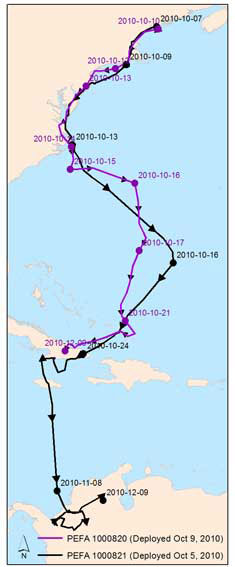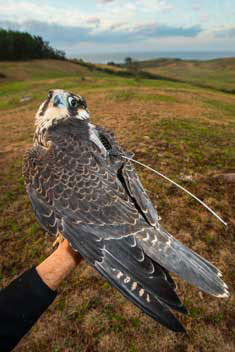Characterizing the Diurnal and Nocturnal Raptor Migration at Monhegan Island, Maine
Each fall, tens of thousands of raptors migrate along the Atlantic coast as they embark upon an extensive journey from northerly breeding grounds in Atlantic Canada and Greenland to warmer climes extending as far south as South America. In some locations, this migration can be impressive, with hundreds or more raptors passing by a single observation station for days on end.
What We Studied

The fall raptor migration has been relatively well-documented along portions of the Atlantic flyway, and the long-term datasets generated from these efforts have helped biologists detect large-scale population declines in some raptor species such as the American Kestrel. However, some portions of the raptor flyway remain poorly described. Such is the case for the raptor migration that takes place over large expanses of open water.
The lack of information about wildlife movements in the offshore environment has become increasingly evident over the last decade as Maine moves towards harnessing its notable offshore wind resource to meet energy demands. In response to this need, BRI’s raptor researchers conducted what may be the first dedicated effort to study Maine’s offshore raptor migration.
With support from the Maine Outdoor Heritage Fund and the Davis Conservation Foundation, we set up a raptor research station at one of Maine’s most well-known birding hotspots: Monhegan Island. This small island, 10 miles offshore along midcoast Maine, is also known as a place to observe migrant peregrines and other falcons.
We aimed to characterize the offshore raptor migration at Monhegan Island by conducting a standardized count to determine the timing and intensity of the migration during the fall season. We also aimed to determine the direction of flight of migrants relative to a proposed wind energy test site south of Monhegan. We set out to capture and band passing migrant raptors, and specifically aimed to trace (using satellite telemetry) the flight path of Peregrine Falcons between Maine and their wintering areas. Lastly, we wished to determine if nocturnal migrant Northern Saw-whet Owls stopped at Monhegan during migration.
What We Found: Study Highlights

We counted more than 800 diurnal (daytime) migrants leaving Monhegan Island during a one-month period (approximately) in the fall of 2010.
Seventy-four percent of the raptor flight at Monhegan was comprised of falcons. This proportion differs significantly from counts conducted at many nearshore or inland sites, where a substantial proportion of migrants tend to be open habitat and forest-dwelling hawks (accipiters and buteos). Close to half of the migrants counted were Merlins, a small, dark falcon.
In general, migrating Merlins tended to be most abundant in late September, while migrant Peregrine Falcons were increasingly observed in early and mid-October. Of those noted, 88 percent of raptors departed the island in directions between west and southwest, the majority at or below approximately 60 m (200 ft).
We banded 25 raptors, 17 of them Peregrine Falcons. One peregrine was recaptured by another researcher six days later on Assateague Island, nearly 500 miles from the first capture site.
We fitted two migrant Peregrine Falcons with satellite transmitters and tracked their migration route through the Atlantic flyway to their wintering areas in Cuba and Columbia.
We documented, for the first time, that Northern Saw-whet Owls used Monhegan Island during migration. We captured 18 owls during a modest capture effort. We caught significantly more hatching year than after hatching year birds during the surveys, and more females than males.
Significance to Policy

This study established baseline information on the diurnal (daytime) and nocturnal raptor migration that occurs at Monhegan Island, Maine. This site may reflect patterns observed at other islands and offshore. Information documenting the timing, intensity, species composition, and flight characteristics of raptors in Maine’s offshore environment is widely lacking. This data gap limits our ability to make informed siting decisions about the placement of marine-based wind power facilities and other developments. The results of this study demonstrate that islands likely play an important role as stopovers for migratory birds. The study also helps to promote habitat conservation efforts at these sites.
DeSorbo C. R., K. G. Wright, I. Johnson and R. Gray. 2012. Bird migration stopover sites: ecology of nocturnal and diurnal raptors at Monhegan Island. Report BRI 2012-08 submitted to the Maine Outdoor Heritage Fund, Pittston, Maine, and the Davis Conservation Foundation, Yarmouth, Maine. Biodiversity Research Institute, Gorham, Maine. 43 pp plus appendices.
Additional Information
Project Support
This project was supported in part by grants from:
The Maine Outdoor Heritage Fund
The Davis Conservation Foundation


